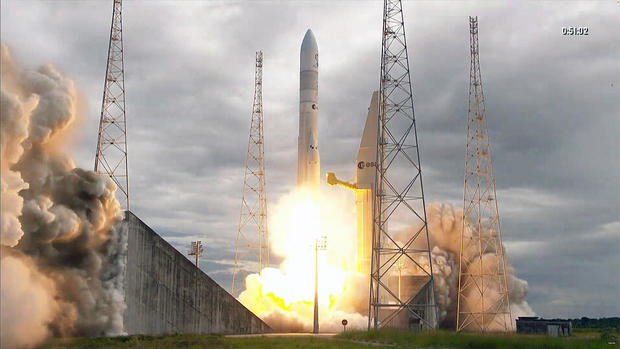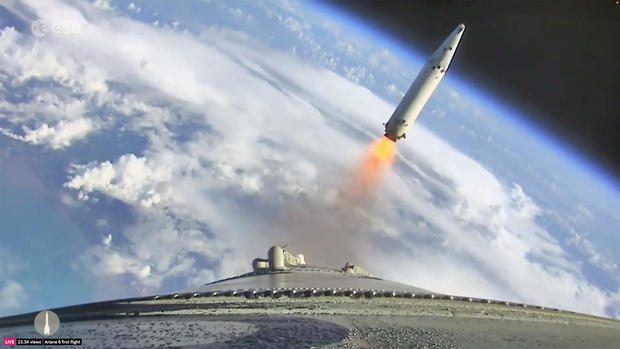Europe launches maiden flight of Ariane 6 rocket
Running years behind schedule, Europe's new Ariane 6 rocket blasted off on its maiden flight Tuesday, thundering away from the European Space Agency's jungle launch site in French Guiana in a bid to restore independent European access to space.
Facing increasingly stiff international competition, Europe's space agencies see the Ariane 6 as critical to re-establishing and maintaining their foothold in low-Earth orbit and beyond, launching European military satellites, science missions, navigation and communications satellites and other commercial payloads.

After the rocket's seemingly flawless climb to space, ending a yearlong hiatus in heavy-lift European launches, mission managers were ecstatic.
"Today, Ariane is back!" said Martin Sion, CEO of ArianeGroup, the rocket's prime contractor. "With this this new launcher, Europe is restoring its autonomous access to space, and we all know how important this is to all of us.
"I'd like to congratulate all of you, to thank all of you," he told flight controllers, engineers and managers in the launch control room. "I'm proud of your talent and your dedication. Now, we have to ramp up production to serve our customers. It is already ongoing, and it starts (with) our next launch before year end."
He made those comments before a problem late in the mission prevented a third upper stage engine firing intended to drive the stage back into the atmosphere as planned. That, in turn, prevented the deployment of two small re-entry capsules designed to test innovative heat-shield technologies.
It wasn't immediately clear what caused the premature shutdown of a new auxiliary propulsion unit, needed to pressurize the upper stage propellant tanks and enable multiple restarts, giving the Ariane 6 the ability to put payloads into different orbits.
Instead, the upper stage was left stranded in space like many other rocket bodies. Its altitude will slowly decrease due to atmospheric drag and it will eventually burn up as planned. But it was unable to demonstrate a controlled re-entry as planned, a key element in the Ariane 6's ability to minimize the creation of orbital debris.
The Ariane 6's long-awaited debut began when the 183-foot-tall rocket's hydrogen-fueled Vulcain 2.1 main engine roared to life at 3 p.m. EDT, followed a few seconds later by ignition of two solid-fuel strap-on boosters, each one generating 787,000 pounds of thrust.

The Ariane 6 majestically climbed skyward atop a combined 1.9 million pounds of thrust, shattering the afternoon calm at the Guiana Space Center and putting on a spectacular, long-awaited show for government and industry dignitaries, launch site personnel and area residents.
Clearly visible through a partly cloudy sky, the two strap-on boosters burned out and fell away two minutes after liftoff. The Vulcain 2.1 main engine, producing 308,000 pounds of push, continued firing for another five minutes before it, too, shut down and the stage fell away, plunging back into the atmosphere where it was expected to break up.
The rocket's second stage then continued the climb to space. After two firings of its restartable, hydrogen-fueled Vinci engine, the upper stage reached its planned 360-mile-high initial orbit one hour after takeoff.
For its maiden flight, the Ariane 6 carried multiple small payloads provided by ESA, NASA, industry, research institutes and students. Among nine deployable satellites were the two experimental re-entry capsules designed to test new heat shield technologies and two NASA "cubesats" built to study radio waves emitted by powerful solar flares.
The auxiliary propulsion unit glitch occurred shortly before a planned third and final engine firing needed to drive the second stage back into the atmosphere for a destructive re-entry.
Assuming the issue is eventually resolved, a second launch is planned before the end of the year. Six flights are booked for 2025, eight flights in 2026 and 10 in 2027. After working off the current backlog, the European space managers expect to maintain a "steady state" of nine launches per year.
"What a giant leap forward for @ESA with the first launch of its powerful, next-generation rocket-and with a @NASASun scientific instrument onboard," NASA Administrator Bill Nelson said in a post on X. "Together with our international partners, we are leading a new era of space exploration."
Liftoff, #Ariane6!
— Bill Nelson (@SenBillNelson) July 9, 2024
What a giant leap forward for @ESA with the first launch of its powerful, next-generation rocket—and with a @NASASun scientific instrument onboard.
Together with our international partners, we are leading a new era of space exploration. https://t.co/5IIvCyExtE
The Ariane 6's launching marked a major milestone for the 13-nation European Space Agency, prime contractor ArianeGroup, the French space agency CNES, which built the launch pad, and Arianespace, the consortium that sells and manages Ariane flights.
The rocket's predecessor, the venerable Ariane 5, was retired last year after 117 flights, including the 2021 launch of the James Webb Space Telescope. The Ariane 6 is roughly comparable to the Ariane 5, but uses upgraded components and is expected to cost 40% less to build and operate.
But unlike SpaceX, which dominates the current launch market with reusable first stages and payload fairings, the Ariane 6 is fully expendable and no components are recovered. Toni Tolker-Nielsen, ESA director of space transportation, recently told Space News that "our launch needs are so low that (reusability) wouldn't make sense economically."
"We don't really need it at this point," he said. "But when we'll launch frequently in the future, we'll need reusability for economic reasons. The second reason to have reusability for a European launcher is sustainability. We must have a circular economy in 10 or 20 years, we need to be sustainable."

The Ariane 6 originally was expected to fly in 2020, but a series of economic and technical hurdles combined to delay the maiden flight by four years.
In the meantime, a joint program with the Russian space agency Roscosmos — launching medium-lift Soyuz rockets from French Guiana — fell apart after Russia's invasion of Ukraine. Adding insult to injury, Europe's small Vega-C rocket was grounded after its second launch ended in failure.
And so, since the Ariane 5's final flight last July, Europe has not had its own rockets to launch European payloads. Indeed, at least four satellites originally slated to fly aboard European launchers were instead carried to orbit aboard SpaceX Falcon 9 rockets.
"You don't want to depend on anybody, and that's why all spacefaring nations want their own access to space," Lucia Linares, director of space transportation strategy and institutional launches for ESA, said in remarks quoted by Nature magazine.
Two variants of the Ariane 6 are planned: one with two strap-on boosters, the Ariane 62, and a more powerful version, the Ariane 64, with four strap-on boosters. A variety of payload fairings are available to accommodate different payload sizes.
Tolker-Nielsen said this "modular" system is ideal from Europe's perspective.
"It's a perfect system because Ariane 62 is replacing the Russian Soyuz, and Ariane 64 is replacing Ariane 5," he said. "So it covers all our needs. Ariane 6 could be the European workhorse for the next 15 to 30 years."
- In:
- European Space Agency
- Elon Musk
- SpaceX
Bill Harwood has been covering the U.S. space program full-time since 1984, first as Cape Canaveral bureau chief for United Press International and now as a consultant for CBS News.
TwitterDisclaimer: The copyright of this article belongs to the original author. Reposting this article is solely for the purpose of information dissemination and does not constitute any investment advice. If there is any infringement, please contact us immediately. We will make corrections or deletions as necessary. Thank you.
Title:Europe launches maiden flight of Ariane 6 rocket
Url:https://www.investsfocus.com









